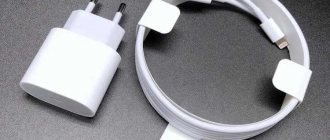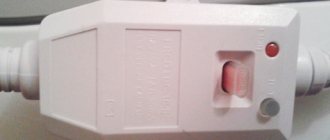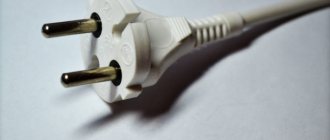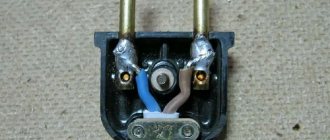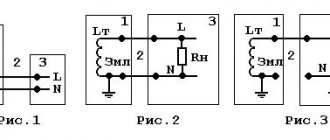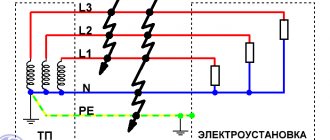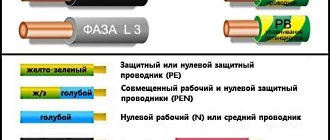Phase imbalance in everyday life
We have already talked about how to determine the phase in the electrical network of your home. But when drawing up a power supply project for your private home, special attention must be paid to the uniform distribution of the load between the phases of the electrical network. This is done in order to prevent phase imbalance during operation of the country house. This is what we will talk about in this article about what phase imbalance is in a three-phase network and what happens if it happens.
Phase imbalance occurs in a multiphase alternating current network when the amplitudes of phase voltages (currents) are not equal to each other. The reasons for voltage imbalance can be different, but the main one is the unsymmetry of currents in the network, caused by load inequality across phases. At the same time, there is a decrease in the power of three-phase electrical appliances.
If we consider phase imbalance from the point of view of operating a private home, there may be a risk of failure or incorrect operation of electrical appliances with a predominant reactive load. These include refrigerator compressors, fans, and devices with simple power transformer power supplies.
You need to know that there are different types of imbalance in the electrical network. In this article, I will look at phase imbalance caused by uneven distribution within the network load.
Most networks, especially those supplying electricity to villages intended for individual housing construction, are three-phase. If the load is unevenly distributed in them, due to which one or two phases are overloaded and the third is underloaded, a imbalance occurs. In practice, this most often happens when electricians have unevenly distributed single-phase loads.
The most common situations are in which, when connecting power to transformers, their power consumption is not taken into account. Thus, it happens that physically the phases have approximately the same number of connections, but the power consumed by these connections is significantly different.
Connecting devices with high power consumption to one of the phases inevitably causes an uneven load between the phases. The same can be said about public and industrial facilities. In all of these cases, it is important to ensure that the load is evenly distributed between the existing phases, this will prevent problems from arising.
Phase imbalance in a three-phase network
The most common arrangement for connecting loads in a three-phase network is called a "star", which is supplemented by a neutral wire connected to a central point and electrically connected to ground.
For ease of understanding, a three-phase electrical network can be represented using an equilateral triangle with a neutral point in its middle. The triangle visualizes the operation of a power transformer at a substation, which is installed in each village and is designed to distribute electricity evenly to all consumers.
By marking the vertices of the triangle with points A, B, C and the middle N (neutral), you can create a formula for the stresses and the relationship between them:
AB=BC=CA=380 V;
AN=BN=CN=220 V.
In this case, the voltages AB, BC, CA are 1.73 times greater than the voltages AN, BN, CN.
A three-phase generator, which is used to power all household appliances and industrial networks, must provide these voltage levels over a wide range of loads.
What happens when there is a phase imbalance
First of all, during misalignment, an uneven load on the phases is observed. In this case, in the overloaded phase, the voltage drops below normal, and in the underloaded phase, a voltage surge occurs that exceeds the permissible values, while the line voltage remains constant. As a result, electrical appliances may fail, especially if they do not have a voltage stabilizer. This is due to the fact that individual devices can either receive less of the required power or receive it in excess. This situation is especially dangerous for powerful devices, for example, water heaters, well pumps, electric boilers, etc.
How to correct phase imbalance
A three-phase stabilizer allows you to prevent negative consequences for equipment from imbalance between phases. It is also often called a transformer for leveling phase imbalance. Unlike household voltage stabilizers, phase stabilizers eliminate asymmetry by amplifying or redistributing the load. The use of this device will eliminate cases when, due to excess power consumption in one phase, electricity is automatically turned off in the entire house.
In principle, the function of a multiphase balun stabilizer can be performed by an assembly of three single-phase voltage stabilizers. The combined use of three stabilizers can provide significant benefits. The principle of operation of a three-phase device is that it has one energy storage and conversion device, which is a pulse transformer. To put it simply, here a single-phase stabilizer installed on the most sag phase is forced to compensate for the increase in voltage by increasing power consumption, which is accompanied by a strong decrease in the efficiency of the converter.
Three-phase stabilizers take the power necessary for equalization from the phases at which the voltage is higher than the rated voltage, due to this the amount of conversion losses is much lower. In this case, an additional load occurs on the unloaded phases, that is, not only the consumer network is stabilized, but also partially the supply network. The presence of a common inverter also allows you to maintain a three-phase network in the event of a temporary absence of voltage on one of the supply phases.
Surge protection for single-phase connections
What should consumers with a single-phase connection do? Unfortunately, it is not possible to influence the likelihood of misalignment and the resulting increase in voltage. Such phenomena happen periodically; it is all due to the insufficient equipment of the main networks, the lack of work on load forecasting and the poor technical condition of electrical networks.
But it is still possible to protect your own electrical equipment. The simplest way is to install a voltage relay that will turn off consumers during a power surge. If even a temporary lack of power supply is unacceptable, there are two ways to protect against phase imbalance: installing a single-phase stabilizer or equipping an ATS input-distribution group with an autonomous power supply.
Consequences of a zero break
The consequences of a neutral conductor break can be completely different. It all depends on in which network the zero-outage occurred: three-phase or single-phase. Let's consider both cases separately from each other.
- Three-phase network. Burnout or breakage of the neutral conductor in a three-phase network can lead to a complete imbalance of the supply phases, as a result of which an increased voltage of 380 V may occur on one line of the electrical wiring supplying household appliances and lighting devices, and on the other it may drop to zero value. Overvoltage, as well as a decrease in the voltage of the electrical network, is dangerous for any electrical appliances and electronic devices. Extreme voltage levels in electrical wiring can cause fire of both the wires themselves and electrical appliances, which will lead to a fire in the room.
- Single-phase network. A completely different picture arises when the “zero” is broken in a single-phase network, which is supplied to apartments and houses from the distribution board. Each power line of a group of lighting devices and household appliances consists of two conductors: “zero” and phase. In addition, in most modern multi-storey buildings, the electrical wiring cable has a third core for connecting protective grounding to electrical appliances, which is not the case in older buildings. When the “zero” in a single-phase network breaks, a dangerous voltage of 220 V appears on the neutral wire.
As we can see, if the neutral wire breaks in any network, both three-phase and single-phase, a number of negative and dangerous consequences can arise.
What to do to prevent such a development of events? Of course there is a way out! Protection against burning out of the “zero” or its breakage is necessary! Below we will consider all types of protection against breakage or burnout of the “zero” in three-phase and single-phase networks. No tags for this post.
Why does the phase disappear and what to do in this case
Imagine that you came home and turned on the light - the lamp did not light up, then you discovered that there was no voltage in the socket, while the circuit breakers or plugs were intact and turned on. Further inspection may show that a phase or zero in the circuit is missing. In this article we will look at why this can happen and what to do if there is no phase on the switch, socket or chandelier.
Reasons for lack of phase
It’s worth saying right away that the phase disappears for one reason - there is no contact. It does not matter whether the cable is broken or the disconnector at the transformer substation is open. Moreover, everything is said for both three-phase and single-phase networks.
Also, not everyone knows that a single-phase 220V network is one of the phases of a three-phase network with a linear voltage of 380V, and between phase and zero in this case it turns out to be 220V. Let's look at what to do if a phase is lost using the example of different situations.
Lighting doesn't work
If there is no light, but the sockets are working, first check for voltage in the socket on the chandelier. In this case, you can check the presence of a phase with an indicator screwdriver, but be careful - there is a high probability of causing a short circuit. We talked about how to use an indicator screwdriver in a separate article.
If there is nothing there, there may be a problem in connecting the wires to the cartridge; if this is all right, then, most likely, a phase has disappeared in the switch or junction box.
This often happens when the switch contacts seem to close, but there is no connection between them, and also if the wires were poorly clamped in the switch terminal block. To check the switch, you need to remove it from the wall and ring whether the contacts close when the switch is closed, and at the same time check whether voltage is coming to it.
If there is no voltage at the switch, the problem is in the junction box or in the wiring between it and the switch. If a phase disappears when you turn on the light, you have a short circuit in the socket, lamp, or in the line from the switch to the lamp.
The socket does not work
There may also be a phase loss in the sockets. This can be easily checked by removing the non-working socket and inspecting the quality of the connections to the wires. If the connections are good, then you need to know how the sockets are powered. In total, there are two connection schemes:
- A train.
- A star.
A loop is when each subsequent outlet is connected to the previous one in parallel, and a star is when a separate line goes from each outlet to an electrical panel or distribution box.
Then, in the first case, you need to check the condition of the terminal blocks and contacts in the previous working outlet in the circuit, and in the second case, inspect the junction box.
In one room
If there is no phase in one of the rooms, pay attention to the electrical panel. If each room is turned on by a separate machine, the machine for this room may have been knocked out, or it may have malfunctioned. In the first case, look for problems in the wiring of the room, and in the second, replace the machine.
If all the rooms are powered by the same circuit breaker, then the problem is in the distribution box that powers that room.
No light in an apartment building
If you find that not only you, but also all your neighbors in the riser have problems with the electricity supply, it means that there has been a break in one of the three phases either in the incoming electrical panel of the house or in one of the access panels. This happens when zero burns out and phase imbalance occurs, when due to overvoltages the load and its currents are unevenly distributed among consumers. As a result, the contacts of one of the connections do not withstand and burn out.
In this case, you cannot fix the malfunction yourself; you need to contact the management company or supply organization so that they send a team of electricians on duty.
Less often there are cases when two phases disappear. In this case, as in the previous ones, you need to check the condition of the circuit breaker terminals on your apartment switchboard and, if all the contacts and terminals of the circuit breakers are apparently in good working order, call a team of electricians.
Independent troubleshooting of access electrical panels is dangerous because you cannot fully disconnect all lines and hang prohibiting posters.
In a private house
If you find that there is no voltage in the network, look at the input circuit breaker; if it is knocked out, turn it on. If after turning on the machine the voltage does not appear, the problem is in the input into the house. It is also possible to lose contacts on the machine. And if, when you turn on the machine, it immediately knocks out, there is definitely a short circuit either in the wiring or in one of the connected devices.
Consequences
For an electric motor, operating in two phases out of three is emergency and extremely undesirable. Also, in three-phase networks, due to the loss of one of the phases, the uniformity of the load of the transformers and the network as a whole is disrupted. For a three-phase electric stove, this mode of operation is not so dangerous - some burners simply will not work. All this leads to increased current in the neutral wire, its possible burnout and further development of emergency situations.
In conclusion, I would like to note that the solution to the problem of lack of voltage in an apartment or on a specific line essentially lies in checking all connections and switching equipment of this line. There are only two reasons for it - either phase imbalance, or burnout of the conductor due to poor contact or increased load. We strongly recommend: when working in electrical wiring, turn off the power and, if possible, work with approved dielectric gloves. Do not interfere with access switchboards and electrical networks - it is better to have this done by electricians from the organization on whose balance sheet this network lies.
Now you know the reasons why a situation arises when there is no phase on the light switch, socket or on the chandelier itself. We hope the tips we provided helped solve your problem!
Household methods for checking the presence of grounding
If it is clear why grounding is needed in an outlet, then the question remains of how to find out whether it works - after all, in practice, the zero in the network is always grounded and, in fact, the connection goes through the same wire. Here you need to understand that in some cases grounding is an additional zero, but if possible with less wire resistance. It is also necessary to take into account that the wiring in the apartment can be done correctly, but if there are no separate terminals for grounding on the access panel, then the wire may be left unconnected until a separate grounding bus is installed in the house.
For the simplest test, you need a voltage indicator or tester, a test light and a screwdriver.
Visual inspection
The first thing you need to look at is the design of the sockets in the house - they may only have two holes for a plug or with additional contacts.
In the first case, it is clear that the design of the sockets themselves does not provide for grounding. The second is that connecting protection to them is possible in principle, but whether it actually exists needs to be checked additionally.
Next, the outlet itself is disassembled - here you need to look at how many wires come out of the wall and what color they are. According to standards, the phase is connected with a brown (black, gray, white) wire, zero with blue, and grounding with two-color yellow-green. In older homes, this may simply be two or three wires of one color. If only two wires are used, then this clearly indicates a lack of grounding. If three wires come out, then additional testing will be required.
Additionally, you need to inspect the panel near the electric meter - if only two wires enter the apartment, this also indicates that there is no grounding initially.
Grounding in the absence of grounding
There is a possibility of detecting only two wires entering the apartment, but when inspecting the sockets, it is clear that the grounding contacts and the neutral wire are short-circuited with each other by a jumper. This connection option is called grounding, but its use is prohibited by the rules of the PUE, since in the event of a short circuit, the voltage immediately appears on the housings of the devices and there is a high probability of electric shock to a person.
Even without a short circuit, such a connection is dangerous in case of a fairly common breakdown - the neutral wire burns out on the input circuit breaker. In this case, the phase through the contacts of the devices ends up on the neutral wire, which, after a burnout, is not connected to ground. The voltage indicator will show the phase in all socket contacts.
About what grounding is and why it is dangerous, watch this video:
How to determine the presence of grounding
If three wires are brought out to the socket and they are all connected to it, you can check the functionality of the grounding with a tester or a regular light bulb.
To do this, you need to determine which wire the phase is on, which is done with a voltage indicator. Moreover, if a phase is detected on two wires, then the network is faulty.
When a phase is found, the light bulb is touched with one wire, and the second is alternately touched to zero and ground. When you touch the neutral wire, the light bulb should light up, but whether there is grounding, you need to look at its behavior - the following options are possible:
- The light does not light up. This means that there is no grounding - most likely, the wire is not connected anywhere in the distribution panel.
- The light bulb glows exactly the same as when connected to the neutral wire. This means there is grounding and in the event of a short circuit the current will have somewhere to go, but there is no protection that responds to leakage current.
- The light bulb begins to glow (in some cases it does not have time to light up), but immediately the electricity in the entire apartment turns off. This means that the grounding is connected and working correctly - there is an RCD on the input panel of the apartment that cuts off the voltage when a leakage current occurs, which goes to the grounding wire.
When checking, you need to pay attention to the brightness of the light bulb or what values the voltmeter shows. If, compared to the connection to the neutral wire, the light bulb glows dimmer (or the voltage is less), then the resistance of the ground wire is higher and its efficiency is low
There is no voltage in the socket and the light is on. What to do if the lights go out or there is no electricity
I’ll say right away that the article is not for electricians, but for ordinary citizens, consumers of electricity. This article may seem like a lot of water, but you must understand that I have a great responsibility - after all, in giving these tips, I am like a doctor prescribing medicine remotely.
Why does the phase disappear and what to do in this case?
Modern housing has a high level of electrification. Therefore, faulty electrical wiring causes great inconvenience. External signs of electrical network failure:
- apartment lighting does not work;
- failure of the socket in one of the rooms or in the entire apartment;
- lack of light in an apartment building, as well as in one of the entrances or a group of them;
- lack of light in a private house or cottage.
The most common malfunction of this building engineering system is the loss of a phase of single-phase and three-phase networks. There is one fundamental reason for all these phenomena - a break in the current flow circuit. The reason is a break in the phase wire, as well as a break in the zero. The location of the break is determined using various techniques.
Socket faults
There are two main reasons why sockets fail:
- Mechanical damage usually appears immediately. Most often they occur when a plug that is not intended for it is forcefully plugged into an outlet.
- If the load capacity is exceeded, the outlet still works for some, and sometimes even for a long time. During this period, the conductive components heat up, after which the insulation and plastic structural elements begin to melt.
A failed electrical outlet can be easily identified by visual inspection, Figure 1. Sometimes this will require disassembling its mechanism.
Possible causes of malfunction
To start repairing, you need to follow the following algorithm:
- Check all outlets. If one product does not work, they look for the reason in it.
- The electrical circuit is susceptible to breakage in weak points, for example, when connected by twisting or unreliable insulation. If everything is fine in the electrical outlet, a break is looked for in the junction box.
- Find out how the voltage went out - the devices stopped functioning or the machine was triggered before that.
- Determine whether the outlet is regular or special for high-power electrical appliances.
In one room there is light, but the socket does not work
The most common problem is when the lights in the room turn on, but the sockets do not work. At the same time, voltage is supplied to other rooms. Possible reasons for inoperability:
- exceeding the permissible load;
- failure of a cable section.
It is necessary to check the electrical wires in the panels, the working part of the power points. If the cable breaks or breaks, call an electrician, as new wiring may be required.
One outlet does not work, but the rest are working in one room
When one power point does not work, the cause may be a loose connection or melted insulation.
If during a visual inspection the cover is melted and the socket does not function, then the contact wire has burnt out. When disassembling the device, the burnt area is visible.
The problem may be in the wire itself, then you need to inspect the cable, check the condition of the core and insulation.
If overheating occurs repeatedly, there is a high probability of destruction of the core, so you will have to replace the faulty piece.
If the insulation breaks, put a cambric or electrical tape on the exposed area. Darkened contacts are carefully cleaned with sandpaper.
Another cause of failure is a short circuit (short circuit). A short circuit is determined simply - the closed section of the conductor is missing, and the inner part is covered with an oily coating. In this case, the socket cannot be repaired - only replaced with a new one.
The socket in the kitchen near the stove or hood stopped working
A stove, hood, and washing machine are appliances with a power above 2000 Watts that require separate sockets. The most common problem is choosing the wrong power point, which is designed for less power. In this case, replace the electrical outlet with a new one with the required value.
What to do if the socket itself is broken, but there is voltage
Before starting repairs, make sure that the outlet can be repaired. The burnt device is replaced with a new one. If there is no voltage when checking with a multimeter, the wires are checked. After making sure that everything is in order with the conductors, proceed with the repair.
To repair you will need:
- Before carrying out work, turn off the power to the apartment. It is prohibited to repair a live power point.
- Unplug devices from the electrical outlet.
- Use a screwdriver to remove the housing.
- Unscrew the clamping bolt and check the quality of the connections. Loose contacts are strengthened.
- Trim the melted ends with a knife or wire cutters. Repair damaged insulation using electrical tape.
- If the clamping bolt is broken, install a new one.
- After troubleshooting, reassemble the socket.
- Turn on the electricity and make sure the problem is corrected. To do this, you need to connect a low power device. If the outlet works without unusual sounds or odors, the repair was successful.
